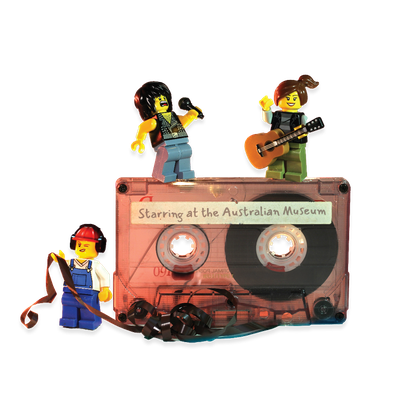Your search returned 2110 results
By Page Type
By Tag
- fish (966)
- blog (696)
- fishes of sydney harbour (401)
- First Nations (299)
- Blog (236)
- AMRI (169)
- archives (164)
- Eureka Prizes (146)
- Aboriginal and Torres Strait Islander (135)
- insect (126)
- Ichthyology (124)
- geoscience (109)
- minerals (102)
- climate change (99)
- podcast (94)
- Fish (91)
- Anthropology (89)
- International collections (80)
- Minerals Gallery (78)
- wildlife of sydney (78)
- Labridae (77)
- frog (74)
- gemstone (70)
- photography (66)
- history (64)
- Mollusca (60)
- gem (59)
- staff (59)
- Birds (56)
- Gems (56)
- Indonesia (56)
- education (56)
- shark (55)
- AMplify (54)
- people (53)
- earth sciences (50)
- exhibition (50)
- past exhibitions (50)
- Gobiidae (48)
- sustainability (46)
- Pomacentridae (45)
- Serranidae (44)
- lifelong learning (42)
- science (42)
- Earth and Environmental Science (41)
- Syngnathidae (41)
- Ancient Egypt (40)
- Bali (40)
- bird (40)
- dangerous australians (40)
-
Compost
https://australian.museum/learn/climate-change/climate-solutions/clever-homes/compost/Turn your food scraps, coffee grounds, paper and grass clippings into super soil to improve your harvest and reduce the production of greenhouse gases.
-
ਸਿਆਣੇ ਕਸਬੇ (Smart Towns)
https://australian.museum/learn/climate-change/climate-solutions/smart-towns-pa/ਸਾਡੇ ਕੋਲ ਪਹਿਲਾਂ ਹੀ ਗਿਆਨ ਅਤੇ ਤਕਨਾਲੋਜੀ ਹੈ। ਅਸੀਂ ਅਜਿਹੇ ਸਥਾਨਾਂ ਦੀ ਸਿਰਜਣਾ ਕਰ ਸਕਦੇ ਹਾਂ ਜੋ ਰਹਿਣ ਲਈ ਵਧੀਆ ਹਨ: ਸਿਹਤਮੰਦ, ਟਿਕਾਊ, ਪੁੱਗਣਯੋਗ, ਕਾਢਕਾਰੀ ਅਤੇ ਮਜ਼ਬੂਤ ਭਾਈਚਾਰਿਆਂ ਦੇ ਨਾਲ।
-
Quan tâm đến đất Nước của chúng ta
https://australian.museum/learn/climate-change/climate-solutions/caring-for-country-vi/Chúng ta là một phần của thiên nhiên. Đất nước này nuôi dưỡng chúng ta và tất cả chúng ta đều có trách nhiệm chăm sóc lại cho đất nước này .
-
Nhà Thông Hinh
https://australian.museum/learn/climate-change/climate-solutions/clever-homes-vi/Chúng ta có thể làm rất nhiều thứ tại nhà để giúp xây dựng một tương lai lành mạnh cho chính chúng ta và trái đất .
-
Fish Section Students 2022
https://australian.museum/learn/collections/natural-science/ichthyology/fish-section-visitors/fish-section-student-visitors-2022/Every year many students visit the Australian Museum as part of their Honours or PhD research.
-
Turf roof
https://australian.museum/learn/climate-change/climate-solutions/smart-towns/turf-roof/Turf roofs are part of 'greening' our urban landscapes. Bringing nature back improves community health, climate change and nature systems.
-
Geothermal heating and cooling
https://australian.museum/learn/climate-change/climate-solutions/clever-homes/geothermal-heating-and-cooling/Geothermal energy takes advantage of the steady temperature under the Earth's surface and can be harnessed to heat and cool your home.
-
Glossary of fish terms
https://australian.museum/learn/animals/fishes/glossary-of-fish-terms/This page lists many of the terms used throughout the site.
-
Reflections from Dr Pat Hutchings
https://australian.museum/about/history/people/oral-history-pat-hutchings/Dr Pat Hutchings was the Australian Museum's first Senior Principal Research Scientist and has dedicated her life to the study of polychaeta sea worms. In this video series, she discusses her early career, establishing a world class collection and the importance of the Australian Museum.
-
Gem deposits
https://australian.museum/learn/minerals/gemstones/gem-deposits/Gem deposits are a very important group of mineral deposits, forming in a variety of geological environments and occurring in rocks of all ages from thousands of millions to recent times.
-
Discover more
2025 Australian Geographic Nature Photographer of the Year
Special exhibition
Free entry
Now open -
Discover more
Unfinished Business
Special exhibition
Free entry
Now open -
Discover more
Wansolmoana
Permanent exhibition
Free entry
Open daily -
Find out more
Burra
Permanent kids learning space
Free entry
10am - 4.30pm![]()
-
Discover more
Minerals
Permanent exhibition
Free entry
Open daily![]()




